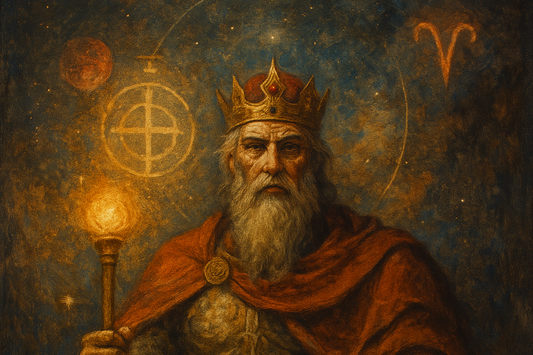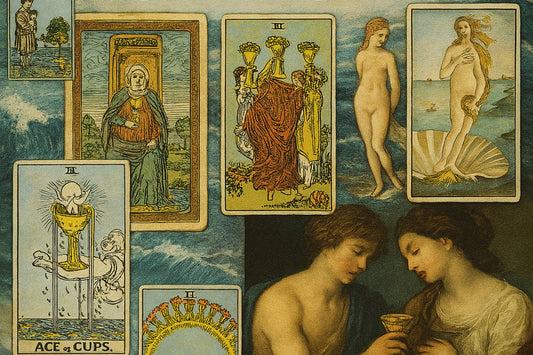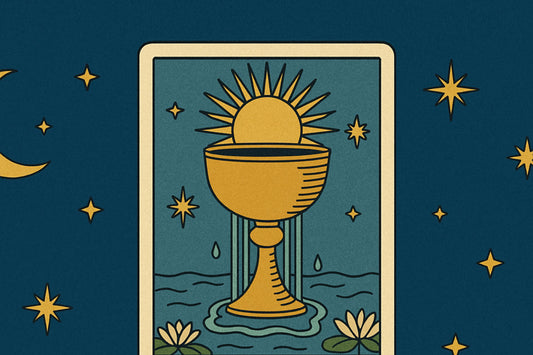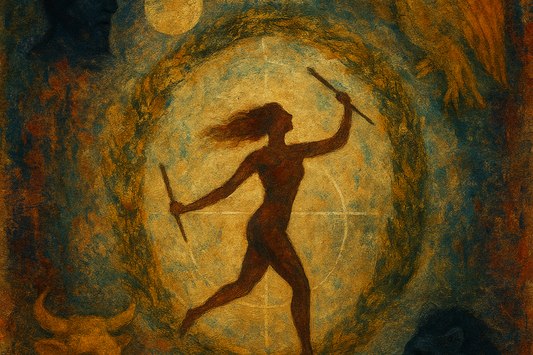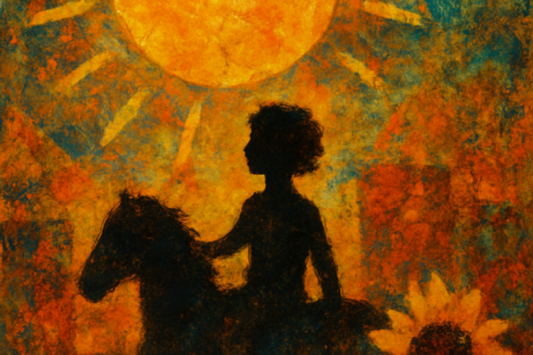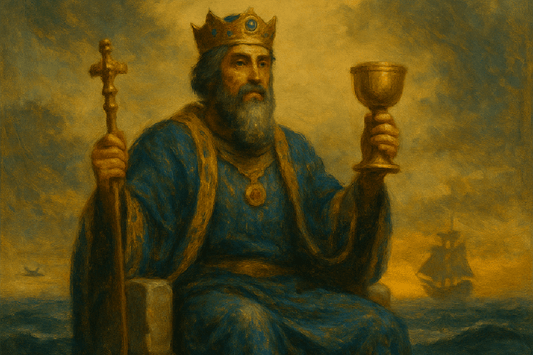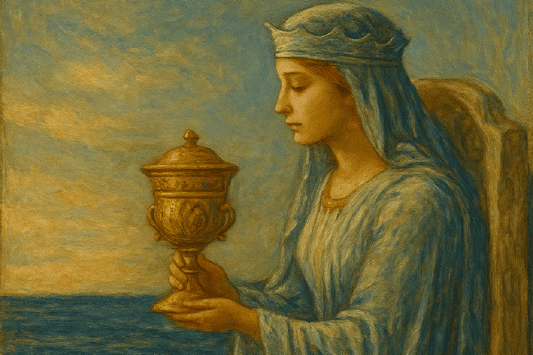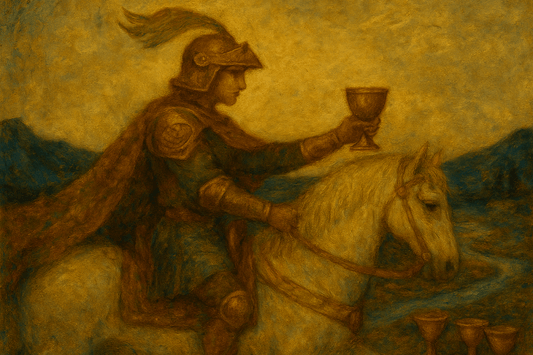The Emperor in Tarot: Structure, Sovereignty and the Archetype of Order
Tarot AccessoriesTable of Contents
- TL;DR: The Emperor Quick Reference
- The Archetype of The Emperor in the Tarot
- Symbolism and Imagery of The Emperor
- Meaning of The Emperor in a Tarot Reading
- Reversed Meaning of The Emperor in a Tarot Reading
- The Evolution of The Emperor Throughout History
- Numerology and the Number Four in Tarot
- Astrological Resonance of The Emperor
- FAQs About The Emperor in Tarot

TL;DR: The Emperor Quick Reference
Upright: Structure, stability, authority, discipline, protection, leadership, boundaries, order, divine masculinity, sovereignty, law, rulership
Reversed: Rigidity, control issues, tyranny, fear of vulnerability, abuse of power, insecurity masked as dominance, disconnection from emotion, rebellion against structure, paternal wounds, overcompensation
The Archetype of The Emperor in the Tarot
The Emperor is the structure that holds. He is the container, the boundary, the lawmaker, the builder. Where The Empress flows and creates, The Emperor fortifies and protects. He is the archetype of divine order - not to restrict, but to stabilise.
He governs not through chaos, but through clarity. His presence in a reading brings the energy of discipline, structure, and masculine sovereignty. He speaks in foundations, frameworks, and long-term vision. This is not the warrior - this is the king who has already won the war, and now governs the land.
But The Emperor isn’t cold. At his best, he is steady, not rigid. He offers safety, not control. He reminds us that true power is not loud - it’s grounded. It’s knowing what must be done, and doing it with integrity.
When The Emperor appears, you’re being asked to claim responsibility for your domain - your time, your energy, your decisions, your creations. Where are you building? What are you standing on?
Related Cards to Explore
The Suit of Cups in Tarot: 14 Ways of Feeling
The Ace of Cups in Tarot: Emotional Awakening and Sacred Flow
Astrology of the Suit of Cups in Tarot: Planetary Meanings & Zodiac Correspondences
The Fool in Tarot: Sacred Trust, Archetypal Innocence and New Beginnings
The Magician in Tarot: Manifestation, Will and the Power to Begin
The High Priestess in Tarot: Inner Knowing, Mystery and Sacred Stillness
The Empress in Tarot: Fertility, Creation and Archetypal Abundance
The Hierophant in Tarot: Tradition, Transmission and Sacred Order
Symbolism and Imagery of The Emperor
In the Rider-Waite-Smith deck, The Emperor sits on a stone throne adorned with ram heads - symbols of Aries, action, and assertive leadership. He wears a red robe, representing passion and vitality, but beneath it, armour - a reminder that his power is not unguarded. He rules from a place of strength, but also of protection.
His long white beard evokes ancient wisdom and timeless authority. He holds an ankh sceptre, the Egyptian symbol of life, in one hand, and an orb in the other - a sign of dominion over the physical world. Behind him, a barren mountain range rises, stark and immovable - a contrast to The Empress’s lush, fertile backdrop.
Where The Empress is Earth’s abundance, The Emperor is its architecture. He builds the walls, draws the boundaries, creates the systems that allow life to thrive. His kingdom is not emotional - it is structural. And yet, without his presence, nothing would hold.
Meaning of The Emperor in a Tarot Reading
When The Emperor appears, you’re being asked to step into structure. This may mean establishing boundaries, creating order, taking responsibility, or holding a firm position. He’s not interested in how you feel about it. He’s asking what you’re building that will last.
This card often shows up during moments of decision, leadership, or when life demands clarity. It speaks to the part of you that wants to get organised, make a plan, protect what matters, and lead from a place of grounded confidence.
In relationships, The Emperor can represent stability, protection, or a strong paternal presence. In career or creative contexts, he invites long-term thinking, clear frameworks, and conscious leadership.
This isn’t about control. It’s about sovereignty. The Emperor teaches that real power doesn’t dominate - it contains.
Reversed Meaning of The Emperor in a Tarot Reading
Reversed, The Emperor often signals a distortion of power - either through excess or absence. You may be clinging too tightly to control, resisting necessary structure, or acting from a place of fear disguised as authority.
This card can point to rigidity, harshness, or a refusal to adapt. It may also reflect wounded masculinity - overcompensating, suppressing emotion, or believing that strength requires hardness. Alternatively, it may show up when structure is completely lacking, and your inner Emperor needs to be reclaimed.
In personal relationships, the reversal can indicate power struggles, controlling dynamics, or issues with a father figure. In work or leadership, it may warn against authoritarianism, micromanagement, or disconnection from the emotional undercurrents of those you lead.
Reversed, The Emperor asks: are you ruling with wisdom - or reacting from fear?
The Evolution of The Emperor Throughout History
The Emperor is one of the oldest and most enduring archetypes in tarot - but he didn’t begin as a symbol of divine masculinity. His earliest iterations were worldly, imperial, and political. Over time, he evolved into an icon of structure, authority, and the sacred masculine.
Early Decks – The Emperor as Holy Roman Sovereign

In the earliest Italian decks of the 15th century - including the Visconti di Modrone, Brambilla, and Cary-Yale - The Emperor appears as a fully imperial figure. He wears a crown, holds a sceptre or orb, and often sits on a raised throne. His posture is confident, sometimes sideways, suggesting awareness of an audience or court.
He wasn’t symbolic. He was literal - a visual reference to the Holy Roman Emperor and the real-life rulers of Renaissance Europe. In a time when tarot was still closely tied to courtly values and political commentary, The Emperor stood in for worldly power, secular governance, and imperial law.
Sceptre, Orb, and the Imperial Eagle
Across early decks, The Emperor’s symbols were remarkably consistent:
- Crown: A clear marker of divine right and monarchy
- Sceptre: Sometimes topped with a fleur-de-lis, cross, or eagle - all signs of royal dominion
- Orb: A symbol of global sovereignty, often cradled in his left hand
- Eagle (or shield with eagle): Commonly placed behind or beside the throne - a reference to the imperial standard of the Holy Roman Empire
These motifs made The Emperor recognisable - not as a spiritual force, but as the patriarchal ruler of the known world.
Variations in Posture and Authority

One interesting variation appears in decks like the Rosenwald Sheet and Budapest-Metropolitan Museum pack, where The Emperor leans sideways, suggesting an active ruler - one who turns to engage his court, rather than sitting in static command.
Some versions - like the Bologna “Tarocchino” deck - show him in profile, sometimes beardless, and occasionally without a crown. These slight shifts reflect the evolving role of the Emperor across political and artistic contexts - from divine monarch to symbolic patriarch.

Marseille Tradition – From Imperial to Archetypal
In the Tarot de Marseille, The Emperor begins to drift away from his earthly associations. While he still wears a crown and armour, his throne becomes more symbolic than literal. His sceptre is stylised into an ankh-cross hybrid, foreshadowing later esoteric interpretations. The eagle remains, but now feels less like a heraldic insignia and more like a totem.
His figure becomes more stoic, more upright, more timeless - less a man, more a symbol.
This transition mirrors the larger arc of tarot’s evolution: from political satire and moral allegory to universal archetype.
Occult Revival – The Emperor as Divine Masculine

In the 19th century, as tarot was absorbed into the occult revival, The Emperor took on layered metaphysical associations.
The Golden Dawn assigned The Emperor to the zodiac sign of Aries, ruled by Mars, linking him to action, assertion, and creative will. He was paired with the Hebrew letter Heh (ה) and placed on Path 15 of the Tree of Life - connecting Chokmah (Wisdom) and Tiphareth (Beauty).
Now, The Emperor was no longer a monarch. He was the energetic architect - the divine masculine force that initiates, protects, and organises the chaos of creation.
Rider-Waite-Smith (1909) – The Emperor Reimagined

In the Rider-Waite-Smith deck, illustrated by Pamela Colman Smith, The Emperor becomes something closer to what we recognise today: the archetypal father, the sovereign self.
He sits on a stone throne carved with ram heads - symbols of Aries. Behind him, bare mountains rise in stark contrast to The Empress’s lush garden. His sceptre resembles an ankh, his orb rests in his left hand, and his beard has grown long and white - a signal of wisdom and time-earned authority.
Gone is the empire. What remains is enduring structure.
Modern Decks – The Emperor as Sacred Masculinity
In today’s decks, The Emperor appears in many forms - from warrior-king to genderless protector to the divine architect of sacred geometry. Some artists restore his imperial trappings, while others strip him back to reveal his essence: structure that holds, power that protects, masculinity that builds without domination.
His message has matured: true strength is not force. True order is not control. And true rulership begins within.
Numerology and the Number Four in Tarot
Four is the number of foundations - of things that last, hold weight, and give form. It’s the number of the square, the table, the compass - structures that allow stability, direction, and clarity.
In the Major Arcana, Four follows Three - The Empress. Where she expands, he contains. She creates, he protects. He is the response to the wildness of abundance: the architect who ensures it doesn't collapse under its own weight.
Emotionally, Four brings structure to chaos. Spiritually, it offers discipline and alignment. Energetically, it roots you. The Emperor, as the archetype of Four, asks: where is your base? And what kind of structure are you building your life upon?
Without Four, nothing sustains. With it, everything can grow in integrity.
Astrological Resonance of The Emperor
The Emperor is ruled by Aries, the first sign of the zodiac - bold, direct, and action-oriented. Aries brings drive, courage, and the instinct to lead. It is ruled by Mars, the planet of willpower, assertion, and primal force.
This gives The Emperor his decisive edge. He acts with confidence, not hesitation. He protects what he builds. He doesn’t wait to be told - he initiates.
Aries teaches us to claim space. Mars teaches us to move forward. The Emperor fuses both into a mature expression of agency - not impulse, but informed action. He reminds us that true sovereignty means knowing when to act, how to lead, and why structure matters.
In a chart or reading, these influences bring the heat of discipline, the fire of initiation, and the clarity of masculine order.
FAQs About The Emperor in Tarot
What does The Emperor mean in a love reading?
The Emperor in a love reading often signals stability, protection, and long-term commitment. It may point to a partner who provides structure and reliability - or highlight the need to create healthy boundaries. In some cases, it reflects a dynamic involving control or power imbalance.
Is The Emperor a yes or no card?
The Emperor is generally a “yes” card - particularly in questions involving leadership, structure, or long-term outcomes. His energy supports action taken with clarity, intention, and accountability. It’s not a quick yes - it’s a grounded one.
What does The Emperor mean when reversed?
Reversed, The Emperor often points to control issues, rigidity, or avoidance of responsibility. It may signal an oppressive presence, a lack of clear boundaries, or a fear of vulnerability masked as dominance. This card reversed is a call to re-evaluate how you relate to power.
What element is The Emperor associated with?
The Emperor is associated with the element of Fire, specifically Aries fire - direct, active, and self-initiating. While he builds earthy structures, his core essence is about action, leadership, and decisive momentum.
What archetype does The Emperor represent?
The Emperor represents the archetype of the Father, the Ruler, and the Architect of Order. He is the sacred masculine - not as dominance, but as grounded protection. He shows up when sovereignty, discipline, or structure is required to move forward with integrity.


